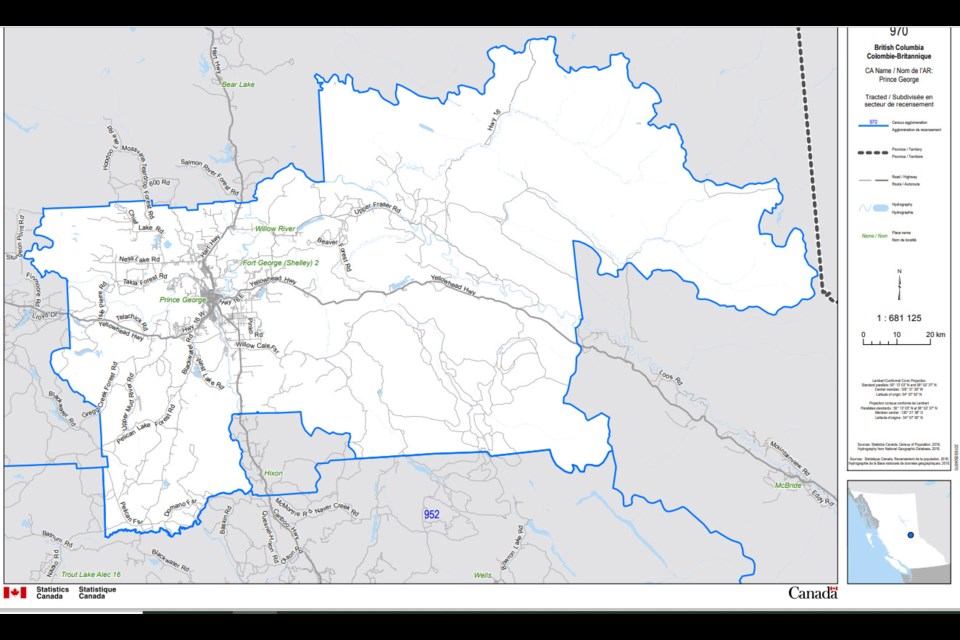The City of Prince George’s population grew by 3.7 per cent between 2016 and 2021, according to Statistics Canada census data released on Wednesday.
The city’s population grew to 76,708, up from 74,003 in the 2016 census. Census Canada recorded a total of 33,643 private dwellings in the city.
The population in the Prince George census agglomeration area – a 17,651 sq. kilometre area around the city, including rural communities like Shelley and Ness Lake – grew 3.3 per cent between 2016 and 2021. The area’s population rose to 89,490, up from 86,622 in 2016. Census Canada reported 39,207 private dwellings of in the area, of which 5,564 were in the rural areas.
Prince George’s population grew slower than the national and provincial averages. Canada’s population grew by 5.2 per cent to just short of 37 million. The province’s population grew by 7.6 per cent to just over five million people.
Prince George’s population growth falls far short of BC Statistics estimates. BC Statistics estimated the city’s urban population – as defined by the Prince George City North, Central and Southwest community health service areas – at 82,290 in 2020.
Prior to the release of the census data, BC Statistics was projecting Prince George’s population to continue growing for the next two decades, adding roughly 1,000 new residents per year throughout the 2020s. BC Stats estimated the population within city limits to reach approximately 87,500 people by 2025, 92,300 people by 2030 and 97,300 residents by 2040.
WELCOME NEWS, CITY SAYS
City of Prince George manager of economic development Melissa Barcellos said the last few census reports have shown sustained, sustainable growth for the city.
“It’s great to see the census is reflecting continued growth in our population,” Barcellos said. “We’re seeing a trend of really sustainable and manageable growth for Prince George.”
Transient workers who spend a significant amount of time in Prince George, and money in the local economy, may represent a population boom that’s invisible in the census data, Barcellos said.
“Prince George has always benefited from the activity in the surrounding region” she said. “(But) when they fill out their census form, they may not be reporting Prince George as their primary residence.”
Economic indicators for the city are strong and Prince George doesn’t appear to be seeing the kind of boom-and-bust cycles that have impacted some other communities in Western Canada, she said.
The city issued a record value of building permits in 2021, driven by private sector investments in apartment and multi-family condo developments. In addition, the city has seen significant increases in housing prices and the unemployment rate dropped to 3.6 per cent in January.
The biggest challenge facing growth in the city will be to attract the workers needed for local business to expand, she said. The city will be partnering with local businesses on a campaign to market the city to residents in other areas this April.
“People will move somewhere for a job, but will stay for the lifestyle,” Barcellos said. “There is a ton of opportunity, and we want to see the population grow.”
MAJOR PROJECTS A BOON, RISK, CHAMBER CEO SAYS
Major infrastructure projects in the area may be a major driver of the perceived population growth in the city, Prince George Chamber of Commerce CEO Todd Corrigall said.
“Businesses are certainly experiencing steady, and in some cases increasing, numbers of customers that are coming in,” Corrigall said.
There are a number of major projects in the region, which have benefited the city’s economy, he said. However, he said, when those projects have been completed or move on to other areas of the province, the city could see a decline in the economy.
“There is a significant concern,” he said. “If you look at where our province is at for major projects, there are no major projects approved for the next five years. When Coastal GasLink is done… when Site C is complete, we have no major infrastructure projects on the books.”
Prince George needs to use this temporary boom to attract new businesses and skilled workers to the city, he said. The chamber will be working with the city on its attraction campaign, but work should have started sooner to lure the new wave of remote workers from major urban centres.
Attracting workers requires more than just marketing, it means addressing the city’s social issues and making it a more attractive place to live, he said.
“The visibility of it is an issue. This isn’t a new problem. It’s been growing and growing,” he said. “(And) three out of four entrances to the city are not visually appealing. Marketing a community isn’t just outgoing advertising.”
Ultimately, bringing in news business and new industries will be the key to long-term population growth in the city, he said. The recent and ongoing expansion of the Port of Prince Rupert’s capacity, along with railway enhancements connecting the port to major North American markets through Prince George, are “a huge opportunity.”
“We have not done a terrific job of diversifying our economy. We have done a bad job on the attraction side,” Corrigall said. “We have a dearth of space here. Why are we not looking at manufacturing here? There is always space for professional services… (and) industries that are hub services.”



